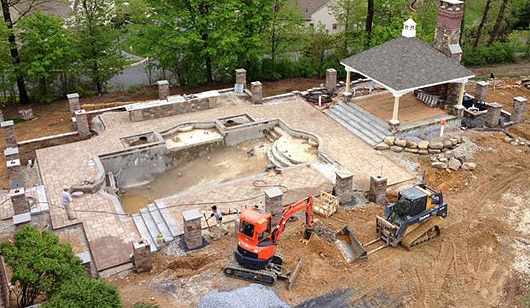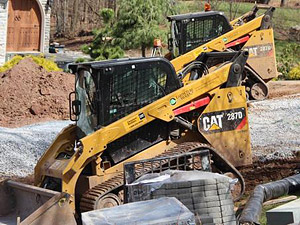Contractor Stories

99% estimating accuracy & tripled sales
Implementing a high level of job costing and budgeting/overhead recovery systems “dramatically” improves profits.
By Tom HatlenIn 2010 Earth, Turf & Wood was cruising along. After 12 years in business, sales had grown to about $800,000 with 5 employees, and they were firmly entrenched in the area’s large-project residential design/build market.
Company president Jarod Hynson had been out of the field several years to focus on managing the company. He had refined his estimating process to where he was very confident in it. Then he met business management consultant Marcus vandeVliet at a seminar. Marcus is president of MV Consultants and is a Vander Kooi & Associates alumni.
Marcus was far less confident in Jarod’s estimating and challenged him on it. Jarod accepted the challenge: “So I asked him to come on up here and prove me wrong. If he was right, I knew it would be a turning point in our company, and it was. Profitability changed dramatically. Dramatically. You can go back to our financials and tell exactly where we were when we implemented Marcus’ system.”
Profile
Earth, Turf, & Wood Inc.
Denver, PAFounded 2000
Jarod Hynson, President
Customer base
100% ResidentialServices
60% Hardscape35% Landscaping/lighting
5% Property care
Largest project
$1.3 MillionAnnual sales
ConfidentialEmployees
13Accurate estimating is huge
By estimating with that degree of accuracy, Jarod says they determine their own profit in advance of the coming year. They set an annual profit margin before each fiscal year starts, and hit that number within 1%.Estimating accuracy leads to scheduling accuracy. “Because our production hours are 98% to 99% accurate we can confidently pack that many more jobs into a season. If we estimate a job will take 183 man-hours to produce, our computerized production schedule will tell us that job is going to take us 5 production days with a 3-man crew. Then we input the next job for 430 man-hours and drop that one in the next production slot.
“This has enabled us to tell a client in July, ‘November 1, we're going to be on your project.’ And, we will be on that project November 1.”
Accurate estimating has also allowed them to do larger projects, some in excess of $1 million. “There is no way that I would even remotely think about building the size projects that we are today without very detailed job costing. When somebody says, ‘I can do that job for 30% less,’ I say, ‘Have at it. I know what my production time on the job will be, and I know we're efficient. You're going to lose your shirt.’”

The spreadsheet days
Jarod says they used to do their estimates on Excel spreadsheets. He had created a thorough process so that estimates would be as complete as possible. But in the end, he says he was just making an “educated guess” on labor hours because they had never tracked their actual time on each task. “Guessing man-hours is dangerous. Why play a guessing game when you can collect all the data and get it right, and not lose sleep at night? Whatever you don't track you can't manage. Whatever you can't manage you can't estimate correctly.”
In contrast, you can manage what you do track. For example, at the post-production meeting held after every job, they go over actual times to estimated times for each task. “If their hours were over the estimate on installing stone base on a patio, chances are it's because they used more stone base than what was in the estimate. 1 + 1 always = 2. If you over-excavated the area for the patio and it required an extra 6 tons of stone base, then obviously it's going to take you more labor to install that extra stone base. Let's talk about how we can fix that in the future.”
In this way, both operations and estimates become that much more finely tuned for each new job.
Employee buy-in
Jarod says it took less than a year to put together solid production times they could use in estimating. Once Marcus had shown him the difference job costing could make, Jarod became convinced that there was no benefit to easing into it. The sooner they began collecting full-scale job costing data, the sooner they would see their profits rise.After Marcus and Jarod explained the program to the project managers, the managers understood that accurate job costing would lead to accurate estimating so jobs would be more profitable, bonuses would be higher and the company would thrive able to support them with better equipment, training, facilities and staff. So, ultimately, job costing was important for their careers.
Jarod says, “Buy-in from employees is really a buy-in in the company. They succeed when the company succeeds.”
Just the same, task times and job codes must be entered on timecards in order to get paid for the week. Jarod likes the saying, “‘Whatever you allow, you encourage.’ If we allow them not to do that, then we're encouraging behavior that hurts the company.”

Getting started
They launched into job costing by getting everyone together in a room and coming up with best estimates for how long it takes to do each task. “We sat down with 200 or 300 codes for different tasks. ‘How long does it take you to lay a square foot of pavers? How long does it take you to install a cubic yard of mulch?’ 2 days and 10 pots of coffee later we had a foundation for starting this program.” Jarod believes it was important to throw out the old numbers his estimators had been using and start from scratch with new numbers developed jointly between both project managers and estimators. That way they got by-in from everyone.
“Then you take that data and put it in an estimating program. Marcus just developed a new one. Then you track your time through a dozen or so jobs and refine those numbers.”
Today, they spend a couple hours every day on job costing. Project managers complete detailed time sheets every night. Admin staff then enter that data into the estimating program every morning. By mid-morning Jarod can see just how each project is progressing compared to the estimate. He says, “It's a painful process to track every minute of every day in production, but the data that we have to estimate future projects – it's great.”
Probably the toughest part of getting started is accepting those first couple estimates you produce from job costing data. Jarod says other contractors have told him the same thing: “Your estimate might be 20% more than what you’ve been doing. The first couple I did I was sure the customer wasn’t going to hire us, but they did.”
Looking back, he says those higher estimates were the right estimates because they had not been recovering their costs. Besides, he says they don’t compete on price. “You lose a job because you didn't listen to what the customer wanted, or you didn't pre-qualify the customer in the interview process. You should never lose a job on price.”

Jarod is a big advocate for tracked loaders. “We went to track machines 7 or 8 years ago and we will never go back to wheeled machines. You lose so much production time in inclement weather. Yes, tracked loaders cost more and they are a little more maintenance, but we can go right out and continue to work through muddy conditions with track machines.”
Recover your overhead
Overhead recovery is the other critical piece of the estimating puzzle. Jarod wishes he would have gotten a good handle on overhead recovery before he left field work, when his salary became overhead. “That's one of the scariest times in a business, when you leave the field and let somebody else do your work. You can think you’re making money and you’re actually losing money because you're not recovering your overhead.”Jarod learned how to create a budget in advance of the coming year to calculate next year’s expected sales, job costs and overhead. The system allows him to recover a share of annual overhead with each job.
Marcus says a good system doesn’t allocate overhead expenses as a straight % of each sale. That’s because a $20,000 job (for example) with disproportionately high labor costs should include a much higher overhead cost than a job $20,000 with high material costs. Labor is the greatest contributing factor toward overhead costs.
The estimating software automatically applies overhead to jobs based on the overhead percentages you’ve assigned to materials, equipment, subcontractors and labor. It also adds all the job-specific costs for all those things based on your job costing data. Then it calculates your profit.
Jarod says, “The estimating system that Marcus helped us implement has really become the backbone of our growth and our success. I wish everyone in our industry would do job costing. It would save so much time and aggravation.”














